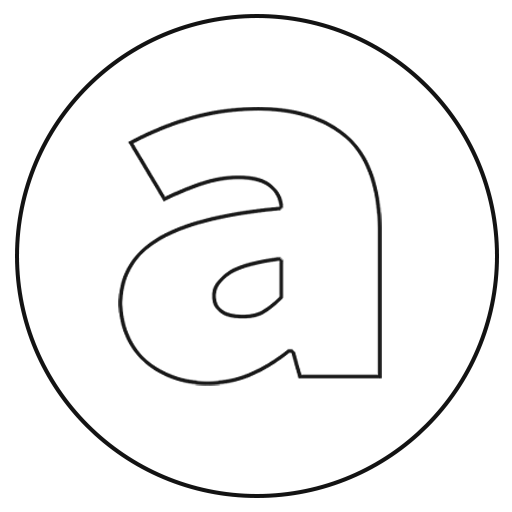Interview with Andrzej Maląg - conducted by Tomasz Ostrowski
You are a visual artist, but by profession you are an electronics engineer, having authored and co-authored over 100 publications and patents in national and international publications.
Yes, I graduated from the Faculty of Electronics, Gdańsk University of Technology in 1974. Later, I did my PhD and habilitation at the Institute of Electron Technology (ITE) in Warsaw in the field of semiconductor optoelectronics. I pursued my interest in the design, construction, and technology of semiconductor lasers at ITE as a researcher and then as the head of the Department of Optoelectronics at the Institute of Technology of Electronic Materials (ITME).
And earlier before polytechnic?
Before Polytechnic, I attended Mechanical and Power Engineering College in Szczecin, specializing in radio and television, a very interesting school. There were teachers there who made me interested in electronics, which I had not been keen on before. It was my parents who persuaded me to choose this direction, arguing that it would be the most future-oriented and modern field of professional activity. I had artistic, painting and marine interests, I wanted to go to the Maritime School. But I was supposed to be an electronics engineer. Professor Jerzy Matyszczak (nicknamed "Czapa") was a very good teacher of radio-receiver devices at the technical school. He infected me and the whole class with modern electronics, which influenced my later decisions. But there was also an excellent Polish language teacher at school - Professor Helena Michałowska (nicknamed "Helcia"), an elderly lady, very dynamic, who directed our interests towards humanities - literature, including ancient literature. I was lucky to have teachers with a vocation. At one point in the Visual Arts Studio of the Palace of Youth in Szczecin, which I attended throughout elementary and secondary school, Mr. Władysław Kołodziński became my instructor. A very interesting and mysterious character. Before the war he studied two faculties, including Art in Lvov. In 1939 he commanded a partisan brigade in the east of Poland. Later he was active in the Home Army. Because of these past experiences, he was a bit withdrawn all the time. However, in his time (in the sixties) in the Art Studio there were photographs of soldiers of the Anders Army hanging in Egypt, e.g. under the pyramids. He taught us a bit about politics. For example, he used the term 'treasonous union', which I couldn't understand at the time. He infected us with ancient culture, the history of ancient Greece, humanism in art, and on the other hand, for example, painting outdoors.
What were your first contacts with art and painting?
Drawing and painting can't interest a person. Somehow, I think you just have it in you. I have always drawn, like all children, but most of them get over it with time. When I found out that there was a Youth Palace with an art studio, I persuaded my parents to take me there, and it was still before elementary school.
What were the subjects of your early interest in painting?
Always the port, the ships and the sea. People - no. I never had, and I don't tend to paint people. I have not painted portraits, but people have appeared in many of my works, but in some not very well-defined context.
As puzzles?
Yes, a little bit.
Professionally, did you work as an electronics engineer, physics technologist?
After graduating from the University of Gdańsk, I was looking for a job in optoelectronics. My studies were concerned with classical electronics: silicon and silicon technologies and such classical electronics, let's call it circuits. However, in "Problemy" magazine I found articles on the optical application of semiconductors, other semiconductors - composite ones, which are chemical compounds - crystals with a direct energy gap. They are capable of emitting radiation. The optical possibilities got me very interested. After graduation, I looked for opportunities to find myself in this field. There was such a possibility in Toruń, where research was conducted and authors from UMK published in "Problems". Finally, I ended up in Warsaw - at the Institute of Electron Technology (IET), where research on semiconductor optoelectronics in Poland was initiated by the group directed by Professor Bohdan Mroziewicz. I could not be admitted to work there because I was not registered in Warsaw, but it was possible to study for a doctoral degree. Later on, we (together with my wife) went to the newly established Radom Branch of the Institute of Physics of the Polish Academy of Sciences. Professor Marian Augustyn Herman organized a branch of the Institute of Physics outside of Warsaw, specializing in semiconductors, solid matter and optics. We spent a few years in Radom, where I prepared my doctoral thesis. At the same time, I was interested in painting. I was now looking for painting inspirations in electronics and in solid state physics, or in physics in general. In "Problems" one could also find articles on astrophysics or quantum physics. I actually came in contact with quantum physics in IET during my PhD studies. My first paintings inspired by quantum mechanics and optics come from this period. And at the same time, all the time I remained in my interest in antiquity and maritime studies. Such composites were created.
What did you look for when creating paintings inspired by quantum mechanics?
Reading mostly articles from the technical press, because there were no textbooks readily available yet, I triggered my imagination in a visual, painterly, necessarily imperfect way. Quantum mechanics is about probability, about indeterminacy, so how to paint it? Such indeterminacy, or something that has some probability. This is generally described by wave functions, so some abstract projections are created.
Looking at your works from different periods, I see that it is more imagined than seen?
Mostly yes. Only the earlier works from the period of my stay at the seaside, in Szczecin, are mainly planners works. Later, since my studies, there have been no planners works. They are all imagined.
Among my works are oil paintings that are illustrations to books I have read. This is another interest of mine, fantasy themes. The paintings are illustrations of Tolkien's novel "The Lord of the Rings." They are invented realistic landscapes. This genre can be called magical realism. You never know if it is more magical or more realistic.
The painting entitled "Grey Harbour" reminds us of the ancient world with its numerous columns, whose unusual structures you created?
Yes, these are imaginary columns. I certainly wasn't trying to replicate what we saw in the movie. It was supposed to be a world from Tolkien, but read, not filmed. I associate this read world more with the classical period than with the medieval one, that the film depicts - everything there takes place in the period and style of the International Gothic, that is the Autumn of the Middle Ages. My vision is more related to antiquity. Because it is supposed to be a different world, so I didn't try to paint historical columns. The contrived designs of the columns are a bit heavy, translucent ('Elf technology'). Apart from that, the painting is compositionally inconsistent - it has two points of convergence of perspective (the gaze separated along the line of columns).
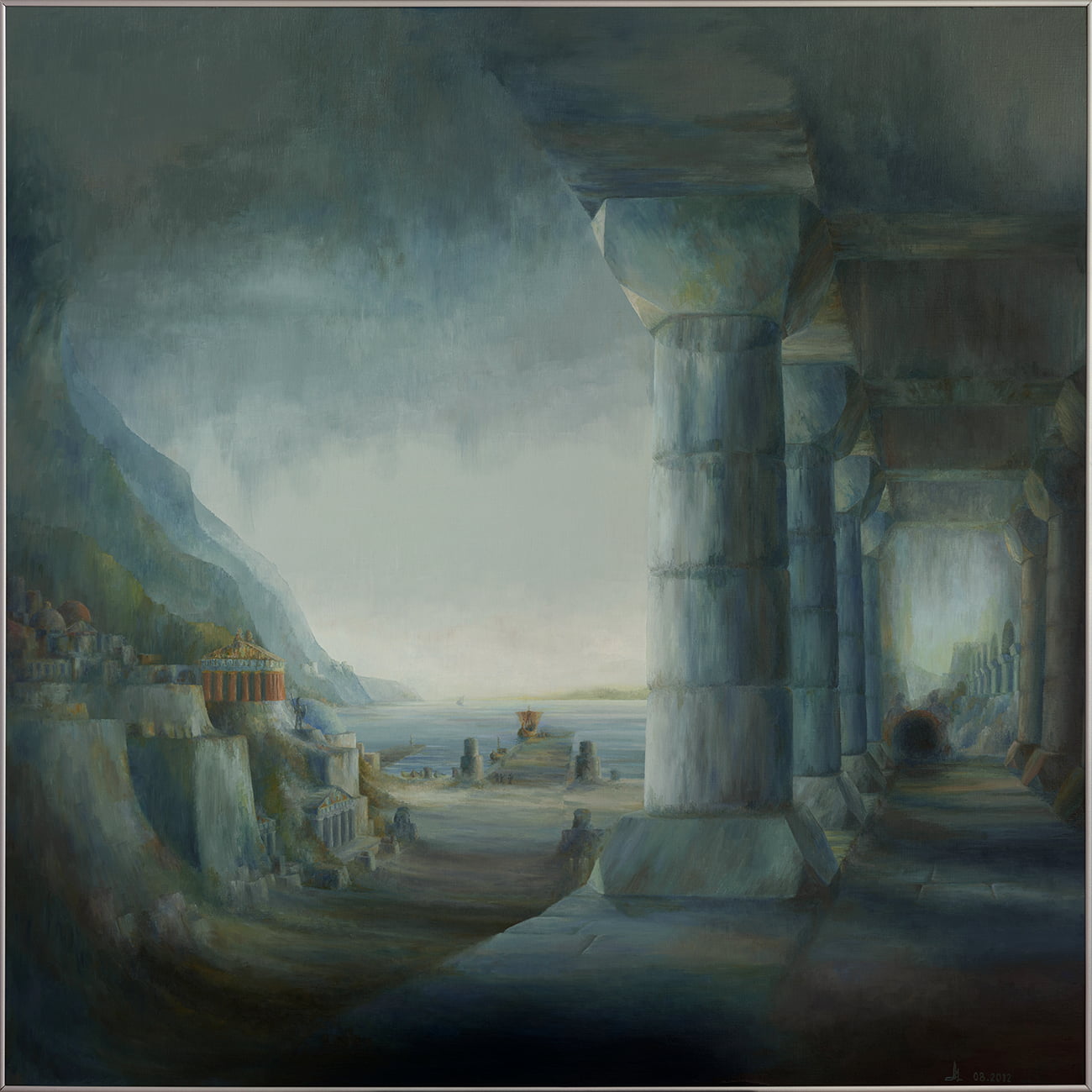
„Grey Harbour” Andrzej Malag
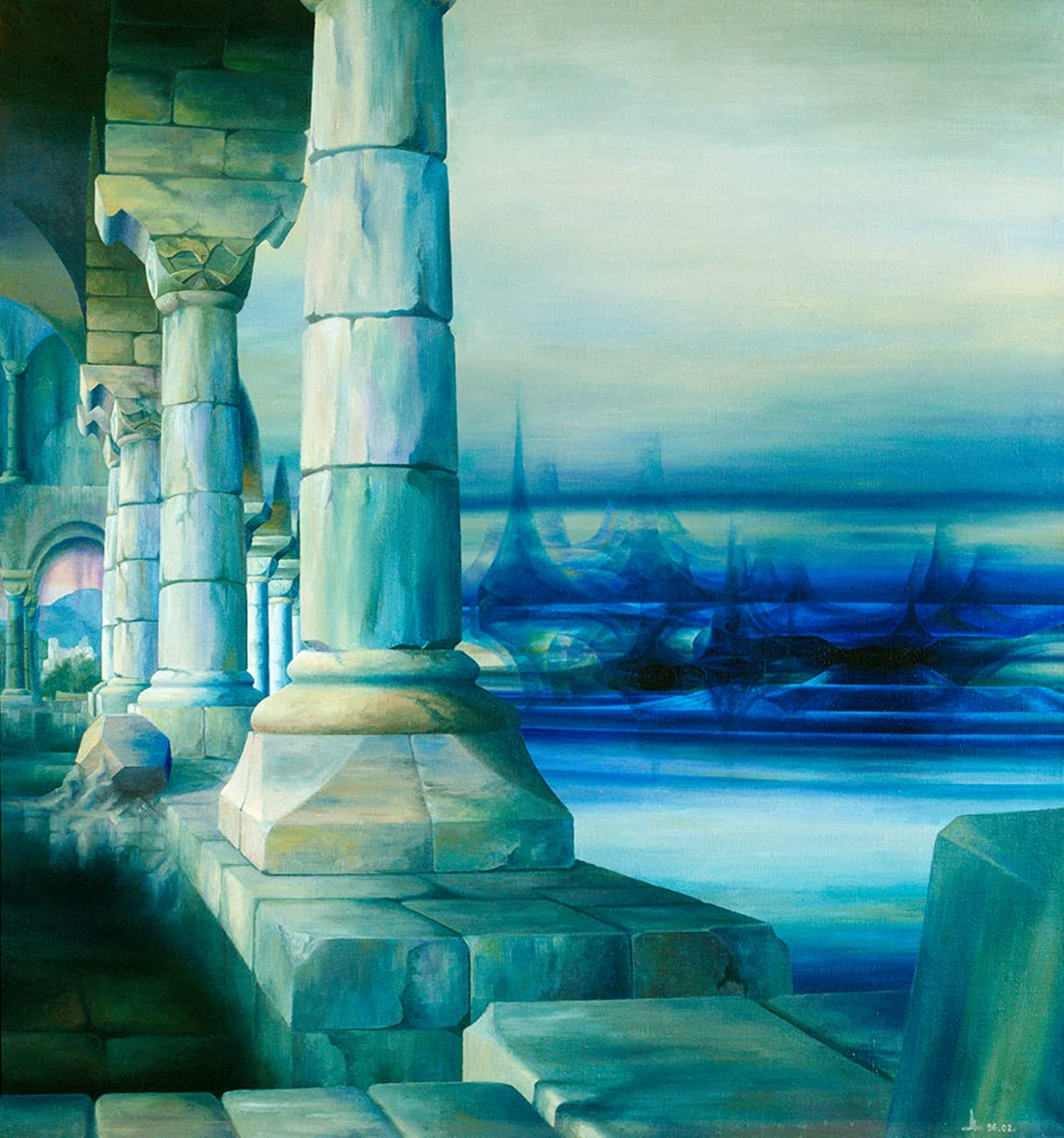
„005” Andrzej Malag
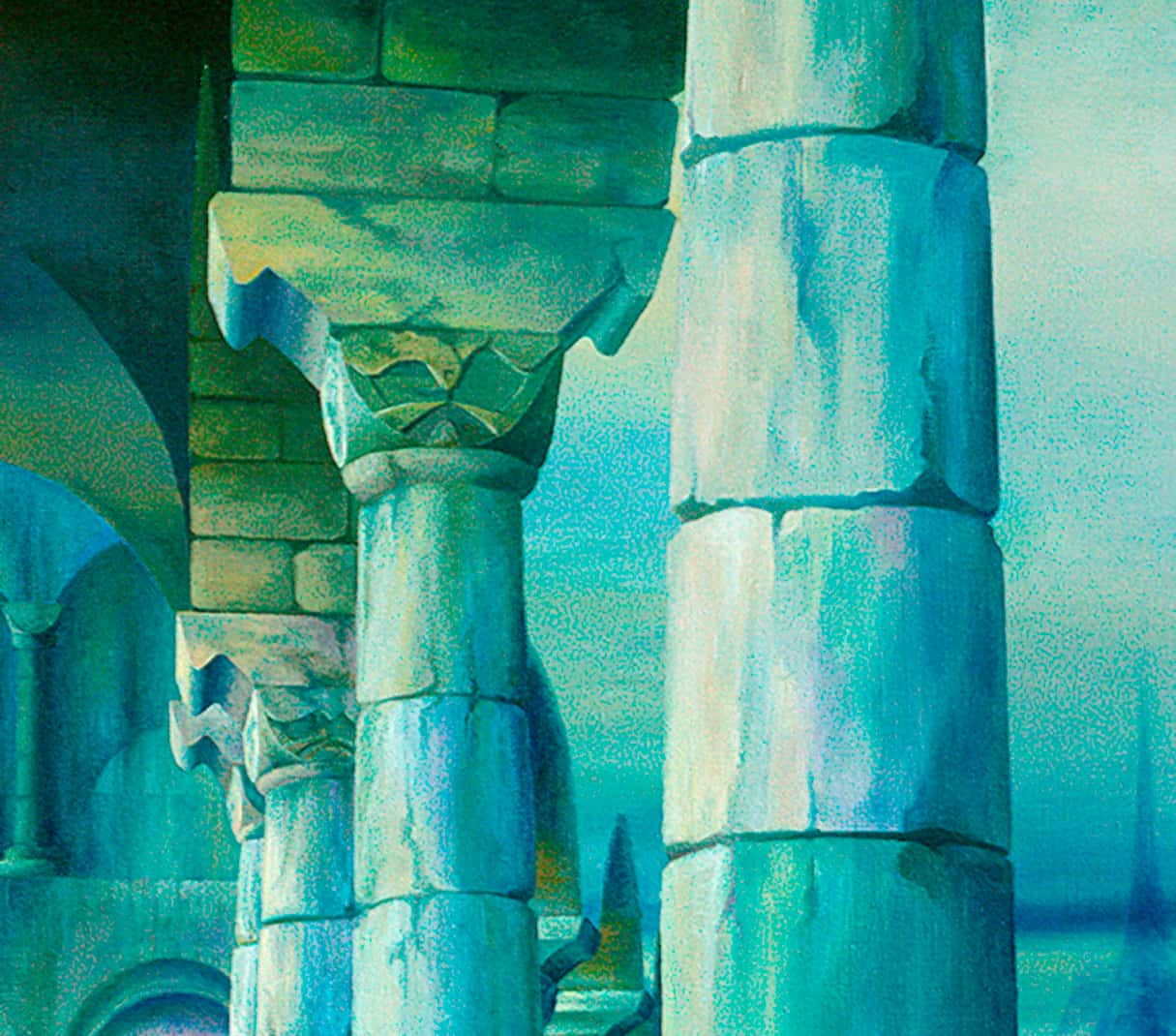
"005" excerpt, Andrew Malag
What are you creating at the moment? In what direction do you find your inspirations?
I would still like to move in the world of fantasy. From a painting point of view, I am interested in compositions created with a set of ordinary paints, combined with metallic silver or gold. Gold, as a rule, does not fit. It has been used since Byzantine times, but never in compositions like landscapes, and if it is, then very symbolically. It is difficult to compose something spatially coherent with it. And this is a kind of challenge.
The image of "Grey Harbour 2" reminds me of a great theater set with emphasized perspective and nice lighting.
Thank you. I think so, too. It's supposed to be Tolkien. Grey Harbor and the last ships sailing away from the Mediterranean to the world the Elves have chosen as an alternative.
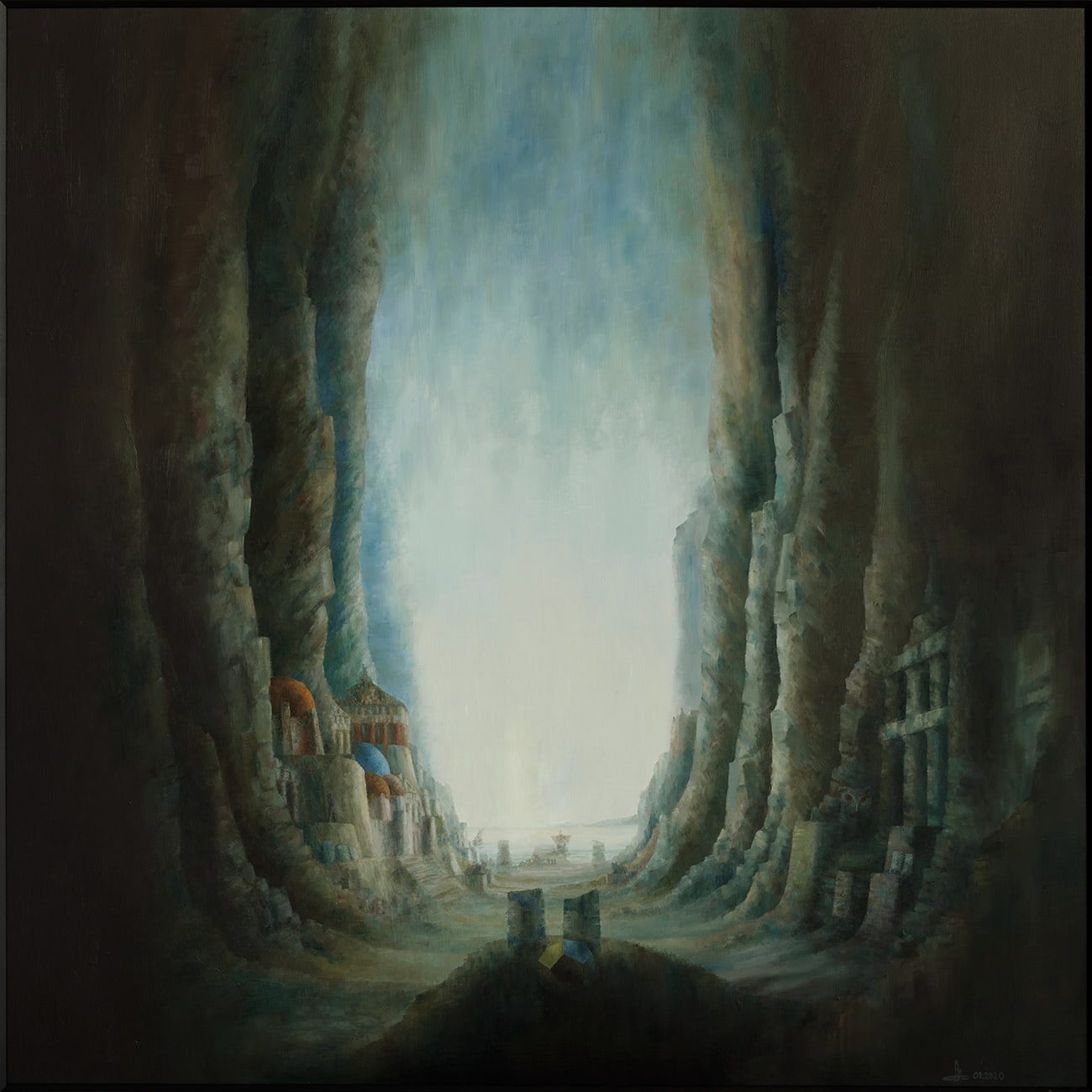
Grey Harbour 2" Andrzej Malag
Is there any plot continuity between these images?
Not all paintings have plot continuity. Not the earlier ones.
In the painting "005" that we mentioned earlier, on the right in the background, we see metaphysical elements that stimulate the imagination.
This is an illustration of something like a quantum transition, with the emission of an event that we observe from the Roman shore in the invisible infrared band.
Inspired by quantum mechanics, do you create your works using techniques other than oil painting?
I have called this part of my work, which is largely inspired by quantum mechanics, interference graphics. Here, the original medium that is the basis of the composition comes from the registration with a C C D camera of interference images of a laser beam passing through pre-designed masks and slits. Through the holes - slits, light passes through. Through the barriers - masks, it does not pass, it passes around the masks. In both cases, interference images are formed at the edges of the masks. These interference images are the basis for electronic processing and building abstract compositions. The images make no reference to the real world. What is more, it is possible to construct colors with the help of computer software, because the interference images themselves (originals) are monochromatic. Often they are associations with phenomena known from physics. The image may be, for example, an illustration of some quantum transition from upper to lower levels. It is a bit of infantile explanation, but it will always be so. Quantum phenomena occur with some probability, they are in constant dynamics. Nothing is constant there. Every moment there can be something different. One can somehow imagine these physical states and process them into abstract pictures.
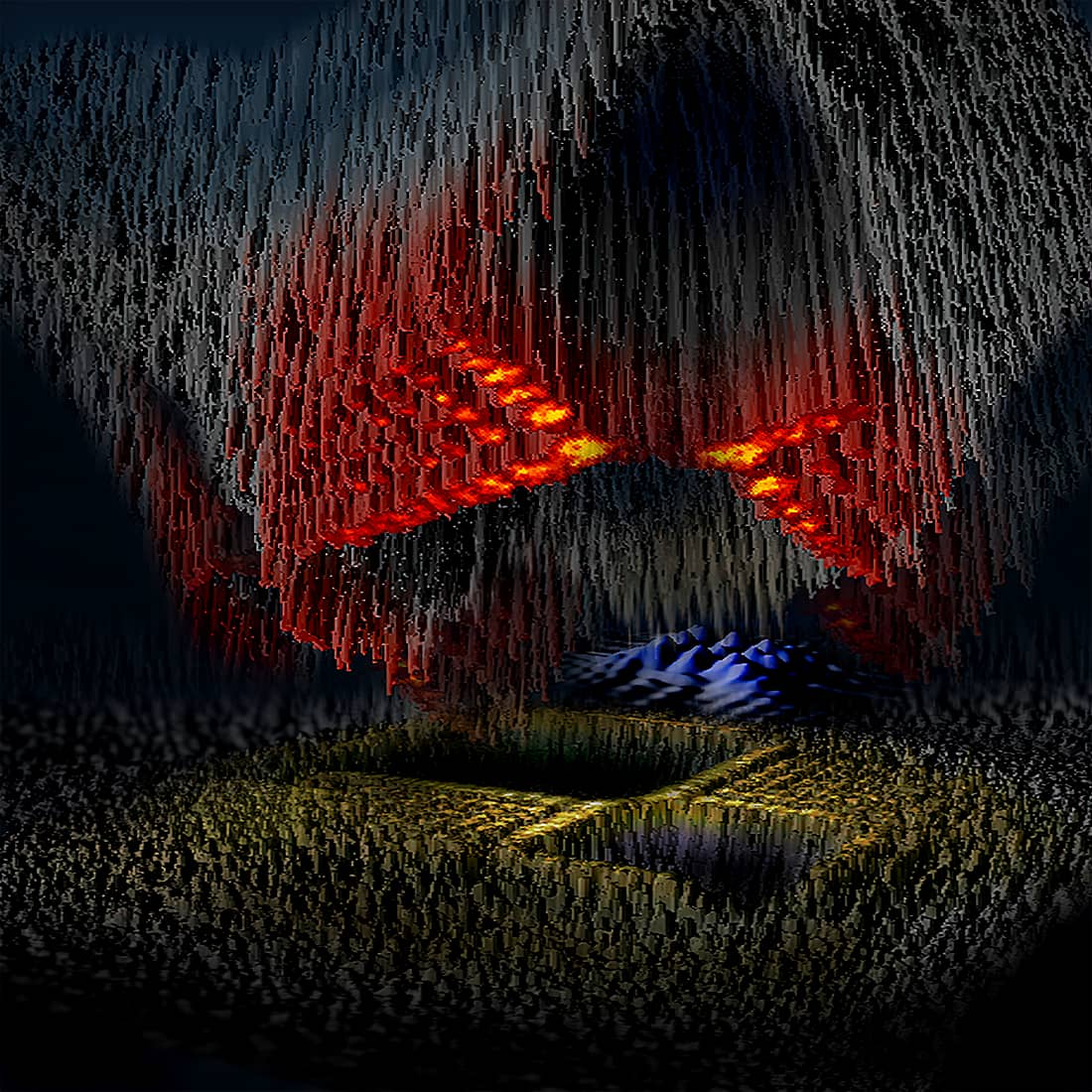
"Composition 12" Andrzej Malag
